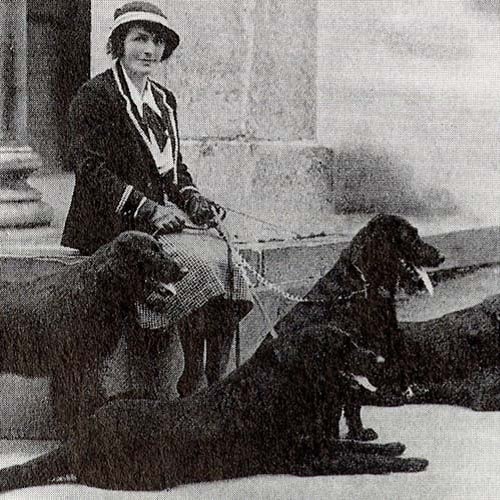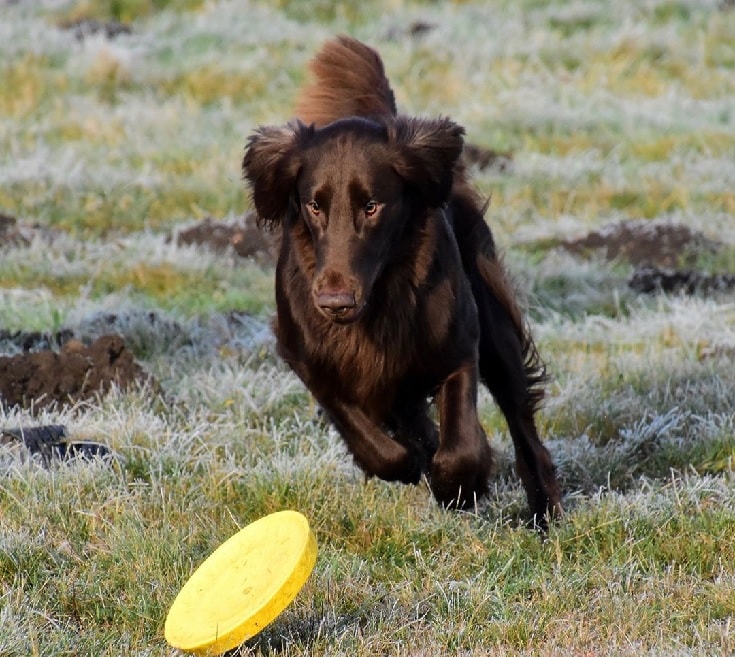Flat-Coated Retriever – Dog Breed Information
General Information
| Dog Name | Flat-Coated Retriever |
|---|---|
| Other Names | Flattie |
| Scientific Name | Canis lupus familiaris |
| Breed Type | Retriever |
| Group | Gun Dog |
| Breed For | Retrieving on land and water |
| Extinct | No |
| Country of Origin | United Kingdom (UK) |
Physical And Size
| Size | Medium |
|---|---|
| Min Life Span | 8 |
| Max Life Span | 10 |
| Min Ideal Weight for male | 27 |
| Max Ideal Weight for male | 31 |
| Min Ideal Weight for female | 27 |
| Max Ideal Weight for male | 31 |
Ranking
| Intelligent Rank | |
|---|---|
| Trainability | |
| Playfulness | |
| Affection Level | |
| Social Needs | |
| Barking | |
| Watchdog Ability | |
| Territorial | |
| Mouthiness | |
| Adaptability |
Characterisitics
| Temperament | Friendly, Smart, Agile |
|---|---|
| Prey Drive | Yes |
| Fighting Dog | No |
Friendliness
| Stranger Friendly | High |
|---|---|
| Child Friendly | High |
| Cat Friendly | Medium |
| Dog Friendly | High |
| Office Friendly | High |
| Apartment Friendly | High |
| Senior Citizens Friendly | High |
| Service Dog | High |
| Search and Rescue Dog | High |
| Biting Potential | Low |
| Country of Origin | United Kingdom |
| Nicknames and Other Names | Flatcoat, Flattie, Flatte, Flatt |
| Scientific Name | Canis lupus familiaris |
| Breed Type | Purebred |
| Group | Gun Dogs, Sporting Dogs |
| Bred For | Retrieve both on land and in water |
| Size | Medium-sized |
| Recognized By | AKC, UKC, FCI, NZKC, KC, CKC, ANKC |
| Life Span | 8-10 years |
| Ideal Weight | 60-70 pounds (male and female) |
| Ideal Height | Male: 23-24.5 inches Female: 22-23.5 inches |
| Fur Type | Smooth and Glossy |
| Common Colors | Liver, Black |
| Markings | None |
| Availability | Widely available |
| Achievements | Won award on field |
| Suitable for Apartments | Not suitable |
| Used in World War | No |
| Most Similar To | Golden Retriever |
Known as the Peter Pan of dogs, the Flat-Coated Retriever is one of the most beautiful and friendly dogs you can ever have. Often confused with the Golden Retrievers, once the GR competed in shows being a part of the Flat-Coated group.
Flat-Coated Retriever Dog Breed loves being outdoor and will play fetch for hours and hours. They make a fantastic family companion with all ages of people. The Flat-Coated Retriever are loving and protective towards its family and territory.
Origin And History
The Flat-Coated Retriever were originated in Great Britain. They were bred as gun dogs crossing between the Newfoundland and various type of Setters, Sheepdogs, Spaniel and Water dogs. The huge and black dogs were traded between Britain and North America eventually becoming the part of the ‘Labrador’ type.
The Flat-Coated Retrievers are also known as the St. John’s Newfoundland, the Small Labrador Dog and the Lesser Newfoundland.
The Wavy and Smooth Coated Retriever which is now known as Flat-Coated Retriever and the Curly-Coated Retriever were not distinguished until 1860 and were also not allowed in the British Show Ring.

Image Source- akc
The Kennel Club Of England was founded in 1873 and the Flat-Coated Retriever entered its studbook in 1874. Later on, the breed gained popularity in both field and show ring.
During the World War I the breed almost got extinct. Fortunately, due to some breeders the Flatties were back to normal number by the mid of 1960s.
They are still a rare breed, ranking 100 on 155 breeds. If you want a Flat-Coated Retriever, then you should wait at least a year or more to get a perfect breed by the breeder.
Behavior Around Children
Want a child friendly pet in your house? Then the Flat-Coated Retrievers are the best breed for you and your children. They loves staying under the supervision of children. Since they are active dogs, they will play for hours whether its swimming, running or chasing a ball.
You should always teach you children how to approach a dog. They might accidentally hurt your children with one whack of their tail.
Flat-Coated Retrievers Are Sweet And Calm
Flat-Coated Retrievers are a smart, intelligent and ever-youthful look. The Flatties are mischievous and exuberant with a high energy level. They adore people even if they’ve met the person for the first time. Flatties love their family and are very protective.
The Flat-Coated Retrievers are excellent sporting dogs and hunters. After the tiring day, they will become lapdogs and also don’t get surprised if you find your Flat-Coated sleeping under your quilt.

Image Source- Instagram @tonjejohanseen
The Flat-Coats tend to be very “Mouthy”. If something they see that fits on its mouth, they will immediately pick it up and run away. This kind of behaviors should be avoided from an early age as it will be difficult to break down in adulthood.
Flat-Coated Retrievers are known to develop separation anxiety and will lead to destruction and chewing. They are truly family dogs and can become quickly depressed when left for a prolonged period.
These breeds are not recommended for people who cannot give their furry friend enough time and affection. A family with a stay home parent can be suitable.
Training Your Flat-Coated Retriever
The Flat-Coated Retrievers are often hard to train as they are willful and want to test the boundaries. Flatties are known to challenge their trainers. An even temper and calm are required while working with the Flat-Coats.

Photo Credit- Instagram @flatpaule
If the Flat-Coated Retrievers are not getting enough of their daily exercise then they will let you know by chewing some valuable things. Active families are best for the Flatties.
Health Problems
| General Health | Healthy |
| Common Health Issues | Cancer, Bloat, Hip and Elbow Dysplasia, Diabetes, Eye Problems |
| Hypoallergenic | No |
| Vaccination Required | Leptospirosis, Canine Parainfluenza, Rabies, Canine Distemper, Canine Parvovirus, Kennel Cough, Canine Coronavirus |
| Shedding | Moderate Shedder |
| Drooling | Low Drooler |
| Grooming | Easy and Minimal Grooming Required |
| Weight Gain Potential | Average to High |
| Separation Anxiety | Moderate Chance |
| Allergies | None |
| Diets and Supplements | Protein: 22% Fat: 8% Omega-3 and 6 Fatty Acids Multivitamins Glucosamine |
Hip Dysplasia
Hip Dysplasia is a condition where the thigh bone doesn’t fit properly into the hip joint. It is also called a heritable condition but can be worse by the environmental factors like injuries while jumping or high-calorie growth.
Gastric Torsion or Bloat
This is a serious condition to large breeds with deep chest who are fed a large meal a day. Bloat occurs when the stomach is swollen with gas or air. This is a life-threatening condition where the dog will be unable to vomit to get rid of air in his stomach and the blood flow to the heart is delayed. Without immediate medication, the dog can die.
Facts About Flat-Coated Retriever
- The Flat-Coated Retriever will hardly move from its spot indoor but they thrive outdoor playing.
- They are known to be the poorest guard dogs among all breeds.
- “Power without lumber and raciness without weediness”. Traditionally, this phrase was used to describe Flat-Coated Retrievers.
Puppies
The cost of a Flat-Coated Retriever is between $1000 – $1200 depending upon the breeders as well as the quality of the breed. The Flat-Coated Retriever gives birth to 4-8 puppies at a time.
Size
Male Flat-Coated Retriever is 22-23 inches tall weighing 60-70 pounds. Females are slightly shorter than males weighing up to 55-65 pounds.
Color Patterns
The Flat-Coated Retrievers are found in only two colors-
- Black
- Liver
Breeds Similar To Flat-Coated Retriever
- Golden Retriever
- Labrador Retriever
- Nova Scotia Duck Tolling Retriever
- Chesapeake Bay Retriever
- Curly-Coated Retriever
Visit Doglime For More Breed Information and their behavior.
Tags










